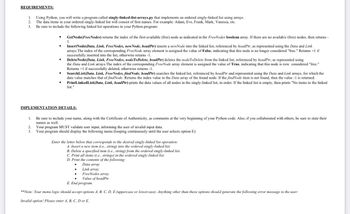
Database System Concepts
7th Edition
ISBN: 9780078022159
Author: Abraham Silberschatz Professor, Henry F. Korth, S. Sudarshan
Publisher: McGraw-Hill Education
expand_more
expand_more
format_list_bulleted
Concept explainers
Question
Please give the algorithm , thanks

Transcribed Image Text:REQUIREMENTS:
1.
2.
3.
Using Python, you will write a program called singly-linked-list-arrays.py that implements an ordered singly-linked list using arrays.
The data items in your ordered singly-linked list will consist of first names. For example: Adam, Eve, Frank, Mark, Vanessa, etc.
Be sure to include the following linked list operations in your Python program:
▪
2.
3.
GetNode(FreeNodes) returns the index of the first available (free) node as indicated in the FreeNodes boolean array. If there are no available (free) nodes, then returns -
InsertNode(Data, Link, FreeNodes, new Node, headPtr) inserts a new Node into the linked list, referenced by headPtr, as represented using the Data and Link
arrays. The index of the corresponding FreeNode array element is assigned the value of False, indicating that this node is no longer considered "free." Returns +1 if
successfully inserted into the list, otherwise returns -1.
1.
DeleteNode(Data, Link, FreeNodes, nodeToDelete, headPir) deletes the nodeToDelete from the linked list, referenced by headPtr, as represented using
the Data and Link arrays. The index of the corresponding FreeNode array element is assigned the value of True, indicating that this node is now considered "free."
Returns+1 if successfully deleted, otherwise returns -1.
SearchList(Data, Link, FreeNodes, findNode, headPtr) searches the linked list, referenced by headPtr and represented using the Data and Link arrays, for which the
data value matches that of findNode. Returns the index value in the Data array of the found node. If the findNode item is not found, then the value -1 is returned.
PrintLinked List(Data, Link, headPtr) prints the data values of all nodes in the singly-linked list, in order. If the linked list is empty, then prints "No items in the linked
list."
IMPLEMENTATION DETAILS:
1.
Be sure to include your name, along with the Certificate of Authenticity, as comments at the very beginning of your Python code. Also, if you collaborated with others, be sure to state their
names as well.
Your program MUST validate user input, informing the user of invalid input data.
Your program should display the following menu (looping continuously until the user selects option E):
Enter the letter below that corresponds to the desired singly-linked list operation:
A. Insert a new item (i.e., string) into the ordered singly-linked list.
B. Delete a specified item (i.e., string) from the ordered singly-linked list.
C. Print all items (i.e., strings) in the ordered singly-linked list.
D. Print the contents of the following:
Data array
Link array
FreeNodes array
Value of headPtr
E. End program.
**Note: Your menu logic should accept options A, B, C, D, E (uppercase or lowercase). Anything other than these options should generate the following error message to the user:
Invalid option! Please enter A, B, C, D or E.
Expert Solution
This question has been solved!
Explore an expertly crafted, step-by-step solution for a thorough understanding of key concepts.
This is a popular solution
Trending nowThis is a popular solution!
Step by stepSolved in 3 steps with 4 images

Knowledge Booster
Learn more about
Need a deep-dive on the concept behind this application? Look no further. Learn more about this topic, computer-science and related others by exploring similar questions and additional content below.Similar questions
- Design an algorithm for determining the day of the week of any date since January 1, 1700. For example, August 17, 2001 was a Friday.arrow_forwardIn questions 4-10 estimate the Big O value by analyzing the code. Note the algorithms are written in English. Hint: you are interested in the number of operations for each algorithm.arrow_forwardSo which of the following above is the correct answer a,b,c or d?arrow_forward
- Please explain step-by-step how to find the time complexity (using Big O Notation) of a straightforward algorithm. (will leave a thumbs up)arrow_forwardd) Prepare a brief report (250 words) comparing the two algorithmsarrow_forwardCan you also analyze the algorithm in Big-Oh notation and provide the appropriate analysis. Please and Thank Youarrow_forward
- Please elaborate on the "apriori pruning concept." Please provide an illustration of this.arrow_forwardHi, this picture is the homework I have and it was on this site so I paid to see the answers, but it only answered question a. Can you show me how to solve the rest of the tasks?arrow_forwardPlease povide a straightforward algorithm and find its time complexity. (will thumbs up)arrow_forward
arrow_back_ios
arrow_forward_ios
Recommended textbooks for you
 Database System ConceptsComputer ScienceISBN:9780078022159Author:Abraham Silberschatz Professor, Henry F. Korth, S. SudarshanPublisher:McGraw-Hill Education
Database System ConceptsComputer ScienceISBN:9780078022159Author:Abraham Silberschatz Professor, Henry F. Korth, S. SudarshanPublisher:McGraw-Hill Education Starting Out with Python (4th Edition)Computer ScienceISBN:9780134444321Author:Tony GaddisPublisher:PEARSON
Starting Out with Python (4th Edition)Computer ScienceISBN:9780134444321Author:Tony GaddisPublisher:PEARSON Digital Fundamentals (11th Edition)Computer ScienceISBN:9780132737968Author:Thomas L. FloydPublisher:PEARSON
Digital Fundamentals (11th Edition)Computer ScienceISBN:9780132737968Author:Thomas L. FloydPublisher:PEARSON C How to Program (8th Edition)Computer ScienceISBN:9780133976892Author:Paul J. Deitel, Harvey DeitelPublisher:PEARSON
C How to Program (8th Edition)Computer ScienceISBN:9780133976892Author:Paul J. Deitel, Harvey DeitelPublisher:PEARSON Database Systems: Design, Implementation, & Manag...Computer ScienceISBN:9781337627900Author:Carlos Coronel, Steven MorrisPublisher:Cengage Learning
Database Systems: Design, Implementation, & Manag...Computer ScienceISBN:9781337627900Author:Carlos Coronel, Steven MorrisPublisher:Cengage Learning Programmable Logic ControllersComputer ScienceISBN:9780073373843Author:Frank D. PetruzellaPublisher:McGraw-Hill Education
Programmable Logic ControllersComputer ScienceISBN:9780073373843Author:Frank D. PetruzellaPublisher:McGraw-Hill Education

Database System Concepts
Computer Science
ISBN:9780078022159
Author:Abraham Silberschatz Professor, Henry F. Korth, S. Sudarshan
Publisher:McGraw-Hill Education

Starting Out with Python (4th Edition)
Computer Science
ISBN:9780134444321
Author:Tony Gaddis
Publisher:PEARSON

Digital Fundamentals (11th Edition)
Computer Science
ISBN:9780132737968
Author:Thomas L. Floyd
Publisher:PEARSON

C How to Program (8th Edition)
Computer Science
ISBN:9780133976892
Author:Paul J. Deitel, Harvey Deitel
Publisher:PEARSON

Database Systems: Design, Implementation, & Manag...
Computer Science
ISBN:9781337627900
Author:Carlos Coronel, Steven Morris
Publisher:Cengage Learning

Programmable Logic Controllers
Computer Science
ISBN:9780073373843
Author:Frank D. Petruzella
Publisher:McGraw-Hill Education